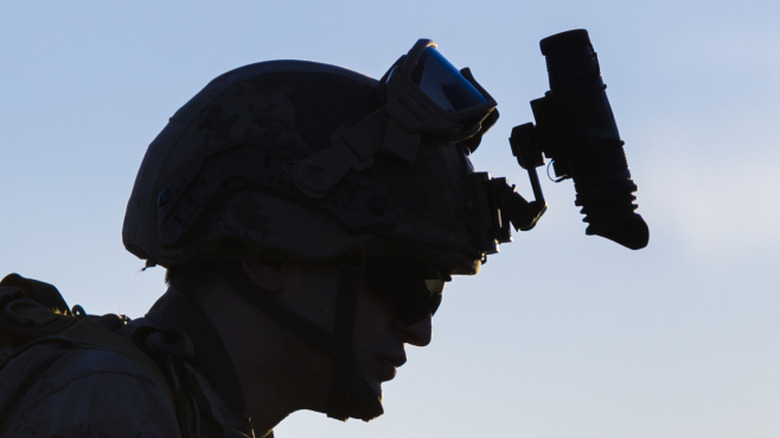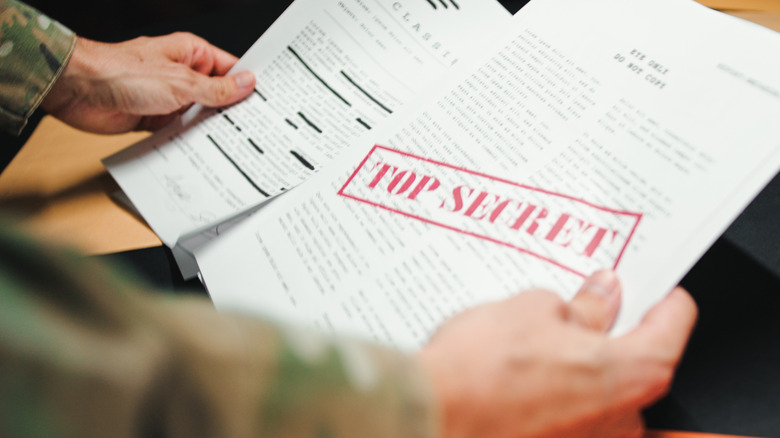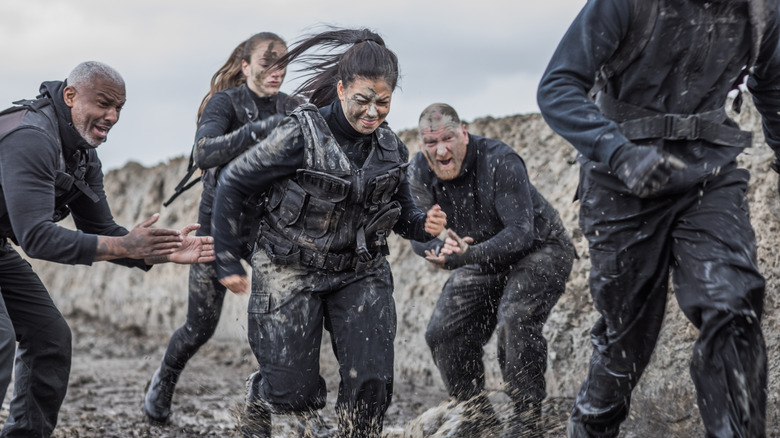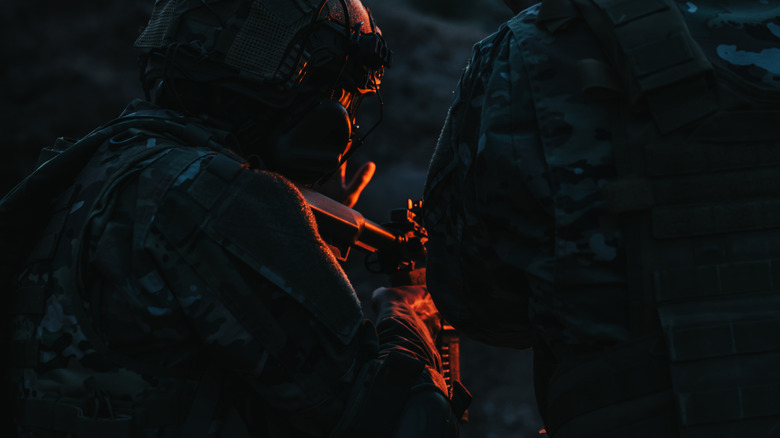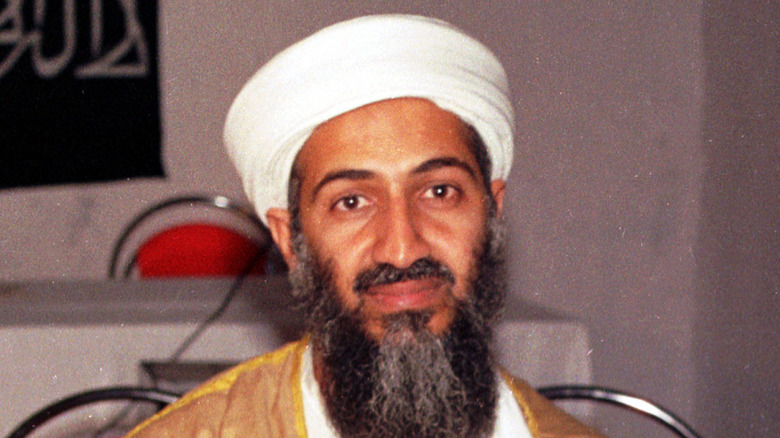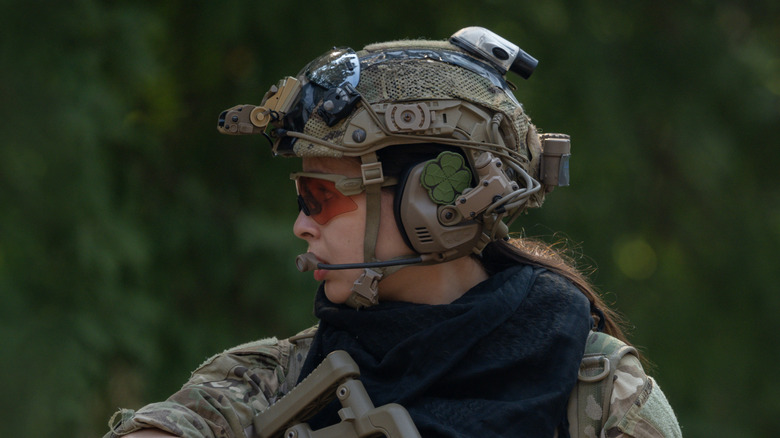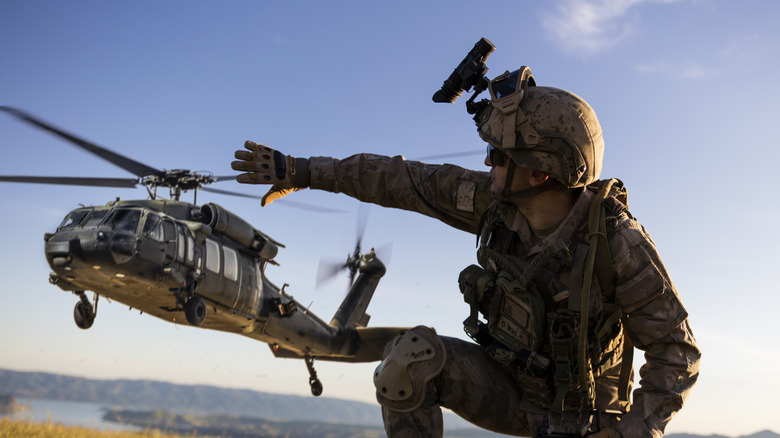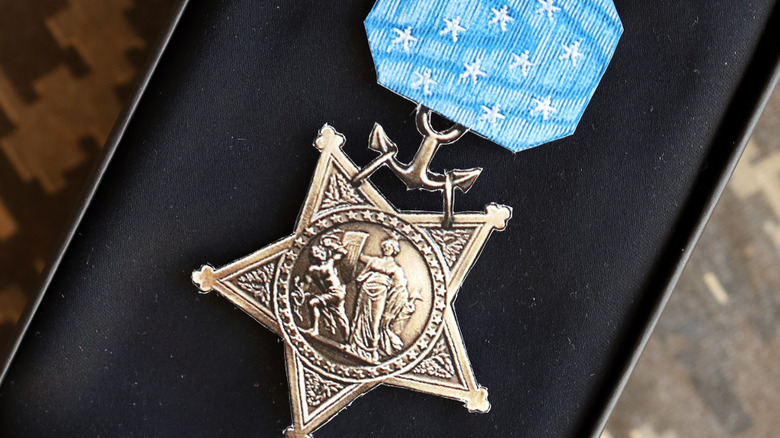Inside One Of The World's Most Elite Kill Teams
We may receive a commission on purchases made from links.
In 2011, retired military operative Howard E. Wasdin spoke to Laura Ingraham in a promotional interview for his then-upcoming book, "SEAL Team Six: Memoirs of an Elite Navy SEAL Sniper." As reported by The New Yorker, he referred to SEAL Team Six as "the best counter-terrorism team in the world." Cloaked in secrecy yet achieving mainstream recognition due in no small part to frequent inclusions in video games and military thriller novels, the clandestine commando unit, officially known as the Naval Special Warfare Development Group (DEVGRU), is among the most elite and enigmatic military units in the world. From tracking down and eliminating important targets to executing rescue missions in hostile environments, this shadowy group operates in the murky realm of classified operations. And while much of what they do remains behind locked doors, the glimpses we get are nothing short of shocking.
Assembled in the aftermath of the failed 1980s rescue mission Operation Eagle Claw, SEAL Team Six was created to be capable of responding quickly, globally, and lethally. Over the decades, the unit has been involved in some of the most daring raids in modern history, including the one that killed Osama bin Laden. But the crew's reputation isn't just built on high-profile successes: It's also layered with controversy, as well as public curiosity about this secretive unit's military structure and operations (including how one can become part of it in the first place). It's time to take a closer look at the covert strike force whose actions have helped shape modern warfare, despite not "officially" existing.
DEVGRU: a shadow unit the government hardly ever talks about
In a military landscape filled with classified missions and covert operations, DEVGRU stands out, rather ironically, by the veil of secrecy that the U.S. government seems to maintain around it. With that said, it's not like the government denies the existence of the elite military group. In fact, on occasion, U.S. officials have specifically attributed certain missions to DEVGRU. Still — and perhaps with good reason — the Pentagon rarely acknowledges its activities, and the White House appears to avoid any direct mention of the group, even when its members are thrust into the spotlight. Case in point: Navy SEAL Edward Byers, who received the Medal of Honor for his participation in a 2012 hostage rescue mission in Afghanistan. As reported by The Washington Post, officials declined to confirm whether he was part of SEAL Team Six, opting instead to describe him as "the first living SEAL to receive the Medal of Honor since the Vietnam War."
While this may seem unfair, it does make sense from a strategic standpoint. Simply acknowledging that a particular military operative is part of an elite kill team, especially if they're still on active duty, can present serious risks to national security, as well as their own personal safety. So, while some stories about SEAL Team Six may occasionally leak or surface through unofficial channels or the very mouths of people who publicly claim to be DEVGRU members, the government's official stance remains consistent: "No comment (unless we comment)."
Not all Navy SEALs can join DEVGRU
Becoming a Navy SEAL trident is already one of the most grueling feats in the U.S. military. But joining DEVGRU requires passing an even higher bar. Before the requisite training and selection process, you need to be an experienced Navy SEAL to even be considered. Compare that to Delta Force, another dedicated military unit specializing in reconnaissance, counterterrorism, and rescue operations. Despite being in essentially the same line of work, Delta Force membership is open to all members of the U.S. Army who are of a certain rank and have at least two and a half years of service remaining. DEVGRU, on the other hand, reportedly does not accept recruits from other Army regiments or units, just Naval Special Warfare operatives who have rendered at least five years of service as a SEAL and served two deployments.
Now, this isn't to say that other members of the army are pushovers — far from it. But the kinds of missions that DEVGRU members are involved in require competencies that SEALs are the most likely to possess and hone. As you can probably guess, the real reason you wouldn't survive Navy SEAL training is because it's hard. Based on reports from the Navy itself, about four in every five SEAL applicants drop out of the Basic Underwater Demolition/SEAL (BUD/S) training phase. (Not to intimidate you any further, but read this if you've ever wondered how many Navy SEALs have died during training.)
DEVGRU candidates are tested to their limits
When it comes to joining DEVGRU, Navy SEAL membership is just a foot in the door. To actually get in, candidates have to endure a long and secretive selection process under the supervision of DEVGRU's training and evaluation unit, the Green Team. Engineered to push even elite SEALs beyond their limits, this phase — the Operators Training Course — is designed not just to test physical endurance but also to expose candidates to any mental, emotional, or tactical weaknesses that might compromise the team in the field.
Outside observers (meaning the general public) can only guess at the true intensity of the selection process. But based on publicly available resources, Green Team training is pretty much what you'd expect from SEAL instruction, but dialed up to 11. The first part involves Close Quarters Battle (CQB) drills, in which candidates practice shooting at close range and in cramped quarters by using a variety of firearms to clear warehouse-sized "kill houses." The next phase involves candidates skydiving from up to 35,000 feet in the air and waiting until they reach a low altitude (about 2,000 feet above ground) before opening their parachutes. Last is Survival, Evasion, Resistance, and Escape (SERE) training, where they learn how to keep themselves alive during dire situations or escape captivity.
According to reports, approximately half of the remaining candidates don't make it to the end of the Operators Training Course. It typically lasts anywhere between six and eight months. If it's any consolation, candidates who fail to get in can eventually try again.
DEVGRU members regularly train with the best of the best from other countries
So you've made it into DEVGRU — congratulations! The work doesn't stop at getting in, though. Staying in DEVGRU demands relentless physical and operational excellence. Unlike conventional Navy SEAL units, DEVGRU operators are expected not only to maintain fitness levels far beyond baseline standards but also "to operate in complex and fast-moving environments," per The New York Times.
It's not enough to pass the usual SEAL fitness test — DEVGRU members are held to a much higher benchmark year-round. This includes advanced strength, endurance, and combat skills, the kind that you can only hone through training with other elite forces from around the world. Alongside Delta Force, DEVGRU trains with the Australian Special Air Service Regiment (SASR) and the British Special Air Service (SAS) and Special Boat Service (SBS) as part of a three-way exchange program between the U.S., Australia, and the United Kingdom. The specifics of these collaborative training programs are, unsurprisingly, kept secret. Canada's Special Operations unit, Joint Task Force-2 (JTF2), is also known to coordinate with DEVGRU.
On top of their regular training, DEVGRU members also undergo specific training for particularly important or challenging missions. In 2024, the Financial Times reported that for a year, DEVGRU "ha[d] been training for missions to help Taiwan if it is invaded by China." When asked about this, the Pentagon only commented that U.S. military forces "prepare and train for a wide range of contingencies."
In 2012, DEVGRU operatives demonstrated their world-class hostage rescue capabilities
While the public isn't privy to every single mission that DEVGRU has participated in, the ones we do know about are a testament to why this team is regarded by many as the Navy's cream of the crop. On January 25, 2012, DEVGRU launched a covert rescue mission (named Operation Octave Fusion) in Somalia, parachuting under the cover of darkness to recover American humanitarian aid worker Jessica Buchanan and her Danish colleague Poul Thisted. They had been held captive since October 2011 after being kidnapped in the town of Galkayo by alleged Somali pirates, who demanded $45 million in exchange for their release. Given the urgency of the situation (including evidence that Buchanan was suffering from a potentially serious kidney infection), armed troops landed at a nearby town, traveling to the location of the hostages and their captors on foot. In the ensuing gunfight, nine captors were slain, while the military suffered no casualties. Importantly, neither hostage was harmed during the rescue mission.
Officially, the rescue team consisted of special operations forces across different military units, per the statement of Pentagon spokesperson George Little. According to various news reports, however, U.S. officials who requested anonymity confirmed that the operatives involved in the rescue mission were indeed part of SEAL Team Six. Reportedly, the team was prepared to capture the kidnappers alive. Further confirmation came via the statement of Buchanan's brother, Stephen, who specifically thanked SEAL Team Six for rescuing his sibling.
The team can bring down its full might at a moment's notice
Seemingly in line with America's approach to warfare in recent decades, DEVGRU isn't built for routine patrols but for fast, lethal precision at the highest level of urgency. The unit maintains what seems to be a nonstop global deployment tempo, ready to strike anywhere with little warning. Though there is hardly any official confirmation from the government, it can be assumed that SEAL Team Six can be activated at a moment's notice to conduct high-risk raids with national-level stakes.
With that said, there have been concerns about the government's apparent overuse of SEAL Team Six. "They have become sort of a 1-800 number anytime somebody wants something done," former senator and retired SEAL operative Bob Kerrey told The New York Times. He noted that U.S. special forces like DEVGRU tend to be the last resort for "situations where the choice you have is between a horrible choice and a bad choice, one of those cases where you have no option."
One controversial example took place on January 28, 2017, when SEAL Team Six (referred to by President Donald Trump only as "service members," per ABC News) led the Yakla raid in central Yemen. The mission targeted an al-Qaida compound believed to hold valuable intelligence and high-value militants. While it succeeded in killing al-Qaida operatives, it also resulted in the deaths of Chief Petty Officer William "Ryan" Owens and a number of civilians, including an 8-year-old girl.
In 2011, the team reportedly eliminated Osama bin Laden in less than 40 minutes
On May 2, 2011, inside a compound in Abbottabad, Pakistan, members of DEVGRU's Red Squadron executed one of the most well-known counterterrorism missions in U.S. history. It was a decisive blow in response to a devastating terrorist attack that took place nearly a decade earlier. And based on what has been confirmed about the timeline of the killing of Osama bin Laden — the man who claimed full responsibility for the 9/11 attacks — the mission (codenamed "Operation Neptune Spear") didn't even take more than an hour to be completed.
Operation Neptune Spear involved 79 U.S. troops (including 23 SEALs), a military working dog, and specially modified stealth Black Hawk helicopters. The team breached the high-walled compound under the cover of night, clearing multiple floors of the building. Despite one of the helicopters hard-landing inside the compound, the operators pressed on. Within 40 minutes, bin Laden was eliminated, sensitive materials were secured, and the team was on its way out, all before local forces could properly retaliate.
Per the CIA, this level of efficiency was made possible by the fact that DEVGRU rehearsed the raid in the weeks leading up to the mission. Notably, the team utilized a full-scale replica of the compound that had "movable interior walls to prepare the assault teams for any internal layout." (Read more about some of the strange things everyone ignores about SEAL Team Six.)
Black Squadron: the secret team within the secret team
Aside from the recruitment-centric Green Team and assault-focused Red Squadron, SEAL Team Six has other color-coded units, including the assault-centric Gold, Silver, and Blue Squadrons and the mobility/transport-centric Gray Squadron. But among these crews, there's one that operates on a deeper level of secrecy than the rest: the Black Squadron, perhaps best described as a confidential unit within a confidential unit.
Originally designated as the unit's dedicated sniper team, Black Squadron changed its focus after the September 11 attacks. According to The New York Times, it now conducts "advance force operations," a broad term that covers intelligence gathering, surveillance, and setting the stage for raids before the other operatives charge in. Basically, if DEVGRU is a powerful firearm, Black Squadron is the laser sight that ensures that it hits the target. Another thing that sets Black Squadron apart from the other DEVGRU color teams: It includes female operatives, which is an uncommon feature in the traditionally all-male SEAL pipeline.
In addition to intelligence-gathering tasks, the unit also supports overseas espionage-style missions, helping teammates blend into environments where solo male operatives would be too conspicuous (aka "profile softening"). They even infiltrated villages in Afghanistan, disguised as tribespersons while planting bugs in the homes of unsuspecting locals ahead of military strikes. As of 2015, Black Squadron is estimated to have over 100 members and typically works in coordination with the U.S. government's other intelligence operatives.
Operators can strike effectively almost anywhere on Earth, with unparalleled, cutting-edge gear
Speaking to the New York Times in 2015, the United States Special Operations Command stated that the Armed Forces "have been involved in tens of thousands of missions and operations in multiple geographic theaters and consistently uphold the highest standards required of [them.]" Given the scope and urgency of the missions that SEAL Team Six handles, it's safe to assume that its members are at the forefront of these globe-trotting operations, armed to the teeth with sophisticated weaponry. While few details are known about the specifics of DEVGRU training, it's clear that the unit is trained to dominate any environment on the planet. Whether operating in the freezing Arctic, sweltering jungles, urban sprawls, or remote deserts, these elite SEALs are prepared for any unfavorable environmental conditions they might face.
But it's not just training that gives DEVGRU its edge — the team's equipment is a blend of precision and secrecy, too. Most of their loadouts are classified, but glimpses into their tech-savvy toolkit surface occasionally, such as in the aftermath of the 2011 bin Laden raid. When one of the stealth-modified Black Hawk helicopters crash-landed and was partially destroyed, aviation experts analyzing the wreckage identified components not found on any known U.S. military aircraft. A windshield coated with radar-scrambling capabilities, advanced noise-dampening technology, and custom airframe modifications indicated that this state-of-the-art piece of equipment was very likely built exclusively for DEVGRU missions.
Its members are discouraged from chasing the spotlight
If the words of ex-SEAL Team Six member Robert O'Neill are to be believed, he fired the shot that killed Osama bin Laden. "I watched him take his last breaths," he told The Washington Post, describing how he had shot the al-Qaida commander twice in the head. But while the public may have responded warmly to O'Neill's account, his former military associates saw things differently. At around the same time his story started gaining traction, U.S. military leaders released a statement stressing the significance of living as "quiet professionals" as part of DEVGRU. "A critical tenant [sic] of our Ethos is 'I do not advertise the nature of my work, nor seek recognition for my actions,'" said the memo, concluding with a reminder that "classified information is protected by law."
One of the understandable but still odd rules SEAL Team Six has to follow is that its members must maintain complete discretion about their missions, guarding the unit's secrets fiercely. This same culture condemns any pursuit of personal glory, whether it's claiming credit for high-profile kills or revealing operational details. Per TIME, when O'Neill went public about his alleged role in Operation Neptune Spear, he violated the non-disclosure agreements he signed upon joining the Navy. As Don Mann, author of "Inside SEAL Team Six" and a DEVGRU operative for 8 years, summed up: "These things have to be kept quiet for a number of reasons. Talking out like this goes against the fabric of our community."
Despite its reputation, DEVGRU isn't a perfect strike team
Shrouded in secrecy and untold truths, SEAL Team Six carries a formidable reputation for precision and effectiveness. But it has also had its own share of (very public) failures and controversies that serve as reminders that they're very good at what they do — not perfect. In October 2010, DEVGRU operatives conducted a hostage rescue mission in Afghanistan to save British aid worker Linda Norgrove, but it ended in tragedy. During the raid, Norgrove sustained serious injuries from an explosive. According to initial reports, one of her kidnappers wore a suicide vest, and she got caught in the blast. Within days, however, Prime Minister David Cameron released a statement, saying that Norgrove "could have died as a result of a grenade detonated by the task force during the assault." The subsequent investigation concluded that this was what really happened: The involved operatives, who failed to inform their commanders about the incident, were said to have received disciplinary action.
Beyond battlefield miscalculations with severe consequences, SEAL Team Six has also grappled with internal challenges. In 2017, Staff Sergeant Logan Melgar, an Army Special Forces member, died in his own sleeping quarters in Mali, West Africa. The autopsy showed that the cause of death was asphyxiation; disturbingly, the persons responsible had apparently mutilated the victim's throat to mask the incident as a botched tracheotomy. The investigation revealed the involvement of two DEVGRU members and two Marines, leading to criminal prosecutions.
